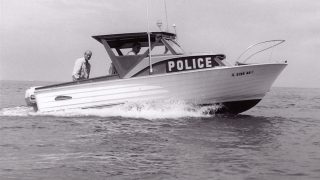
Police in Oceanside, California, have discovered a novel solution to bring aerial drone footage to officers on the ground: by using a screen-sharing feature in the popular videoconferencing tool, Zoom.
Beach team officers in the Southern California department have relied on drones’ bird’s-eye footage, particularly during search and rescue missions and suspect apprehension attempts. The technology has been able to provide officers’ key information on the ground without putting them directly in harm’s way.
Sergeant Jack Reed, Oceanside Police Department’s drone program supervisor, said that drones were especially useful in locating missing children.
“They realized that if they were to have a drone as opposed to riding around in the sand trying to find a kid … [t]hey could generally very quickly identify where the kid was and be able to reunite them with their families,” Reed said.
However, the department faced a problem: it was having difficulty sharing live drone video feeds with officers’ smartphones.
At first, Reed said they tried using a VideoLAN Client player-based app to share the video, but when too many people logged onto the app, it began to lag. During critical operations, technical problems could be catastrophic.
“We’ve had a number of missions where they were looking for overhead intelligence as they were approaching a target,” Reed recalled. “The SWAT commander was unable to pull up the feed for some unknown reason. I don’t know exactly what the technical problem was that caused that. But we were having that problem frequently enough that we were looking for another option.”
With help from the Oceanside Fire Department, police were tipped about the novel features in Zoom that could solve their video-sharing problem.
“We use a screen-share feature like if you were going to be giving a presentation on a Zoom meeting, and then we share the screen generally from the phone that we’re using to fly the drone, log into the Zoom meeting and launch it. We send usually a text out on an app that lets everybody know that the meeting is live. With our account, we basically have the same Zoom meeting and password so that we can all quickly log in,” Reed explained.
The Zoom solution has already been battle-tested in critical SWAT team operations.
Reed shared how Zoom held up during a SWAT team operation to arrest a man who had stabbed someone and was hiding in an apartment complex.
“Obviously, to send a team in against an armed suspect, there’s a dramatic likelihood that that person would try to stab those officers,” Reed explained. “One of the things that we decided to do was to perch a drone on a balcony where they could see between the vertical louvers of the apartment of this particular suspect and see what they could see. See if he was still armed, see what his actions were, see if he was agitated, and use that information so that the SWAT team could make decisions based on what we were seeing. And the Zoom platform gave us the ability to do that.”
Reed said there are still ongoing attempts to integrate Zoom with drones. Currently, footage from only one drone can be broadcast to officers via Zoom. The department is working with Zoom and drone tech company The Unmanned Advantage to develop multiple drone feed-sharing features.
Jorge Alcazar, CEO of The Unmanned Advantage, described the new feature: “The command element will be able to see all three videos at the same time, and it doesn’t take over the screen completely.”
Oceanside isn’t the only police department to embrace drone technology. This past year, the Las Vegas Metro Police have launched its own program as well, which can be read about here.





